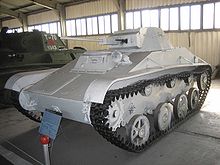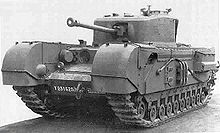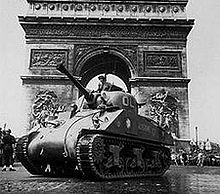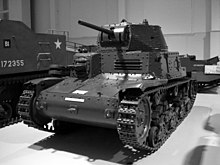Tanks (1933-1945)
Since 1933 the armored weapon developed enormously. New techniques and stronger cannons always produced new tanks .
General
Even in the First World War, the tanks had different shapes; the concepts had to be worked out without experience. In the period between the wars , the tanks developed into a form that has largely been preserved to this day. Tanks were constructed with fully revolving turrets that had primary and secondary armaments. At the beginning of the war, the caliber sizes of the main weapon ranged from 37 mm to 76 mm. The thickness of the armor varied between 10 mm for the light tanks and 100 mm for the heavy tanks. As the Second World War progressed , caliber sizes and armor strength increased. The Germans relied on tried and tested weapons such as the 88 mm L / 56 combat vehicle cannon. The 122-mm cannon was introduced in the Soviet Union ; the heaviest western caliber was the US Pershing tank with 90 mm. The armor was also developed further. Instead of using ever thicker armor plates, however, the armor plates were bevelled so that an opponent's projectile was deflected. Now it was no longer necessary to only reinforce the armor plates in order to ensure greater protection. Likewise were diesel engines used that the radius of action considerably enlarged the chariot. The chassis were also redesigned. Instead of using Holt tugs, as was the case in World War I, or modifying their chassis only slightly, new drives were constructed and adapted to the relevant situations and combat areas.
Another important change was the development of ammunition . Conventional artillery shells were still used during the First World War . During the Second World War, designers on all sides developed types of ammunition that were specially designed for firing at enemy tanks. Hard core bullets with a tungsten carbide core and shaped charge bullets were mainly used.
During the war, a new type of tank prevailed: the tank destroyer . This emerged directly from the anti-tank role of the assault gun . In most cases, a rotating turret was omitted and, except in the front area, there was no stronger armor. For this, more powerful cannons were installed, and the entire vehicle had to be moved for side straightening.
The increasingly mobile warfare required sufficient motorization with armor protection for the support troops. The foundations for developed after the war, armored personnel carriers and armored personnel have been with the relatively weak armored vehicles such as Universal Carrier , M3 or Sd.Kfz. 250 / Sd.Kfz. 251 placed.
German Empire
Soviet Union
As a result of the design of various tank models, the tank weapon gained importance in the USSR from 1938. As early as the Soviet-Finnish winter war , construction defects were revealed in some combat vehicles, but not all of them could be eliminated until the German invasion of the Soviet Union.
Deployments of the Soviet armored troops took place mainly on the Soviet-Mongolian border against Manchurian and Japanese troops ( Japanese-Soviet border conflict ) and were usually successful, therefore the bulk of the mechanized troops of the Red Army in August 1941 were in Asia and not in Europe stationed.
In general, the Soviet tank tactics were based on different principles than the German ones. Soviet tanks were grouped into independent brigades and mainly served to support the infantry. At the beginning of the war, exploiting the operational depth was the task of the infantry and not of the more mobile armored weapons. When the German Wehrmacht attacked with very large tank units in the form of four independent tank groups as part of "Operation Barbarossa", the Soviet defenders recognized the flaw in their tank doctrine. The relatively small tank units were mostly quickly destroyed by the huge tanks of the German Wehrmacht. The general weakness of the Red Army at the beginning of the Second World War was mainly brought about by the political cleansing and a restructuring of the army.
From the end of 1941, however, the operational structures changed. During the winter battle off Moscow in 1941/1942, Soviet tanks were used in large numbers and it was possible for the first time to hit the German troops not only locally but massively. From 1942 onwards, the total restructuring of the Soviet tank forces took place. First tank corps were created, from which tank armies (which often achieved guard status) were formed, the structure of which roughly corresponded to the earlier German tank groups. Well-known commanders of such large formations were generals such as Mikhail Katukov , Pawel Rybalko and Pawel Rotmistrow . The principles of operation and combat doctrine, which the Russian army has maintained to this day, were also changed.
BT series
The BT series , a series of light tanks, was very successful. During the war, the reliable devices became the backbone of the armored reconnaissance forces. The BT series had a light cannon and armor. The maneuverability of the tank and its low specific ground pressure made the vehicle ideal for moving off-road or - crucial for the Eastern Front - in deep snow, which the vehicles proved in the Soviet-Finnish winter war. Their actual combat value became obsolete with the appearance of the German Panzer III and IV and especially after the appearance of the Panther . Vehicles specially equipped with radios served as command tanks. The BT series tanks were used as reconnaissance aircraft well into the 1950s. A special feature of the BT series was that the chains could be removed and the chariot could be wheeled. This enabled the vehicles to reach speeds of up to 75 km / h on the road.
The light T-tanks
In addition to the multi-tower T-35 and T-28 tanks , which were developed in the 1920s, the Red Army also relied on a large number of very light tanks. The prime example of the Soviet light tank, along with the BT series described above, was certainly the T-70 . It was developed in the 1930s as a support vehicle for the cumbersome multi-tower tanks, as a support for the infantry and as a reconnaissance tank. During the German invasion of the Soviet Union, around 8,000 tanks were made, but they turned out to be clearly inferior to Panzer III and IV . So their tasks were mainly limited to the education. Although the armor and armament were adequate for a light tank, it turned out to be disadvantageous that the commander also had to operate the cannon completely. So he was a commander, gunner and loader in one person. There are no reports of any special performance of the T-70 in combat. From 1943 they were completely withdrawn from the service of the tank battalions and only served as training tanks in the hinterland. Its successor, the T-80 , in which some of the most serious defects were corrected, was only produced less than 100 times and production was finally given up completely. One of the most important variants of the T-70 was the SU-76 assault gun . After the T-70 was de facto withdrawn from service, it was decided to continue production of the chassis and to use it to accommodate the 76 mm ZiS-3 cannon as a mobile anti-tank gun. The result SU-76 could not completely convince. The armor of the superstructure was far too light and the tower was open at the top. This was a negative aspect against air strikes and infantry. Nevertheless, the SU-76 proved itself in its main task as close-range artillery support for the infantry.
T-34
The tank that had the most lasting impression on the Soviet armored forces was the T-34 . The tank is considered a milestone in tank construction. This vehicle was the first to have beveled armor plates and was one of the first series tanks to be produced exclusively with a diesel engine. These concepts were later adopted by almost all states that developed tanks. His appearance on the battlefield shocked the German Wehrmacht, as their standard 37 mm anti-tank gun suddenly became ineffective. From this point on, the soldiers mockingly called the cannon “tank knocking device”. The 5 cm L / 60 anti-tank guns and the variant mounted in the Panzer III were only able to destroy the T-34 to a limited extent, usually only to the side / rear.
In addition, the Soviet designers took into account the climatic conditions in the Soviet Union. The T-34 got much wider tracks, so that it was much more agile than the German models in deep snow and mud. The armament of the first models was the reliable 76.2 mm F-34 cannon . Armed and armored in this way, the T-34 was superior to the German tanks III and IV . However, the T-34 also had to go through developments, which is why it was continuously improved. The last variant was the T-34/85 with a much more powerful weapon.
This last variant was used in some countries until the 1990s ( Croatian War ).
In principle, the success of the T-34 lies in its simple construction, which gives it something in common with the American Sherman tank from this period. The designers deliberately avoided complicated subtleties. This made maintenance of the vehicle very easy. Throughout the war, around 40,000 T-34 / 76s of the 1941 and 1943 versions and nearly 11,000 T-34 / 85s were produced . The German leadership was unable to counter this sheer mass with enough battle tanks. In particular, the SU-85 and SU-100 tank destroyers and the SU-122 self-propelled artillery vehicle were built on the chassis of the T-34 .
KW-1, KW-2, KW-85 and IS tanks
In 1938 the Soviet designers developed the KW-1 . This heavy tank was intended to replace the pre-war multi-turreted T-35 and T-28 models , which had proven to be a failure. The KW-1 received the SiS-5 cannon with a caliber of 76.2 mm. Although the concept of the multi-turret tank had been abandoned, strong secondary armament - four machine guns - had been installed. The KW-1 is considered to be the tank that should set the trend for Soviet tank construction alongside the T-34 . At the beginning of the war in 1941, the KW-1 was superior to the German tanks III and IV . Too few specimens were in use at the front for it to pose a serious threat.
In order to take into account the increasingly important support, the Soviet Union built the KW-2 next to the KW-1 . The German tank soldiers feared its heavy armament, as the 152 mm cannon was capable of destroying any enemy tank. The disadvantage was the huge structure, which made camouflage difficult and was an excellent target. Nonetheless, there are reports that Soviet KW-2s repeatedly successfully obstructed the German advance. The main disadvantage of the tank was that the turret could only be rotated on level ground. Therefore KW-2 tanks mostly fired from hidden positions. The last development of the KW series was the KW-85 . Basically it was a KW-1 with a more powerful 85 mm cannon. The chassis and chassis remained largely unchanged. Only the tower had to be renewed to accommodate the heavier cannon. KW-1 and 2 have been replaced by KW-85 . This in turn was replaced by the legendary IS series . The most important tank in this series was the IS-2 .
The IS-2 paved the way for modern Soviet tanks. Its massive main cannon had the very large 122 mm caliber. The IS-2 became legendary because of the many photos that show it in the street fight in Berlin in 1945. Along with ISU-152 - self-propelled guns invaded IS tank as some of the first one in Berlin. Its direct successor, the IS-3 tank, was delivered too late to be used on the Western Front. He was baptized by fire in the Far East when the USSR entered the war against Japan after the German surrender. This vehicle already showed the characteristic turtle tower, which is still considered a trademark of Russian tanks today. The concept of the IS-2 and IS-3 was so advanced that they were in service in various countries well into the 1970s. IS-2 and IS-3 could be equipped with the additional tanks usual for Soviet tanks, which increased the range of the combat vehicle considerably.
Western Allies
During World War II, the US and Britain worked closely together on tank development. British forces used many American vehicles during the war because of the Loan and Lease Act , which allowed the United States' allies to temporarily use US armaments. Basically, the Western Allies divided their armored forces into armored divisions and armored brigades. The latter operated as independent brigades within an infantry division. The experiences of the Second World War did not force the Western Allies, unlike the Soviet Union, to rethink their tank tactics. The battles in Europe and Italy in particular provided for a different, more flexible battle management than in the vastness of the Russian steppe. Due to the dense settlement of Western Europe, the allied tank units were always forced to act in close association with infantry and artillery. From 1944 on, the superior Luftwaffe was added. Tank groups or armies of the kind used by the German Wehrmacht and the Red Army were not planned. This concept has also been largely retained by the USA and Great Britain to this day.
Infantry and cruiser tanks
The British Army divided their tanks into two types, namely infantry and cruiser tanks . Infantry tanks were slow and heavily armored, but only relatively lightly armed, such as B. the Mk III Valentine . With over 8000 copies, the reliable and robust Valentine was considered the most important armored vehicle of the British. The tower only allowed a limited reinforcement of the armament. Usually the vehicle was armed with a 2-pounder cannon and a machine gun. When production stopped in 1944, the Valentine was hopelessly inferior to the newer German tank models.
Another representative of the infantry tanks was the eye-catching Mk IV Churchill . The British had designed a completely new chassis that carried the tank on eleven rollers on each side. In this model, too, the armor was strong and the armament rather weak. The Churchill had a 6 pounder cannon and a machine gun. The unconventional design of the front section, which acted as a bullet trap, which could cause great damage, proved to be disadvantageous. The numerous minor design flaws that caused the model to lose its impact were remedied by the time it was commissioned in 1943, so that from then on the tank proved to be a robust and reliable vehicle. It was not until the 1960s that the last Churchill was decommissioned.
A representative of the class of cruiser tanks was the Mk VIII Cromwell . It was created on the basis of the demand for a heavily armed battle tank that should seek combat with other tanks. For this purpose, the construction received a 75-mm cannon. The Cromwell could not keep up with the performance of German tanks during the war, but it was a valuable tank, especially since the chassis offered various possibilities for further development. From this vehicle there was a large family of vehicles with recovery, observation and command tanks. Ultimately, the Cromwell was replaced by the US M4 Sherman . In anticipation of the D-Day on June 6, 1944, the Cromwell was mainly used as a training tank, as the previous Cromwell units had been converted to Shermans .
The Sherman and its model variants
The M4 Sherman was one of the most popular main battle tanks in the world. During the war, more than 40,000 copies of all variants were made in the United States. The tank proved to be reliable and robust, at the same time it served as an almost modular weapon platform. The US Army used the great potential of the model for constant combat value increases. The tank was also used by the United Kingdom's armed forces , the Free French forces under Charles de Gaulle, and the Red Army under the Lending Act, which allowed the allies of the United States to use American armaments for a limited period of time . Characteristic for the Sherman tank was its high-sided structure. In some situations this turned out to be a hindrance, especially when camouflaging . Depending on the manufacturer and model, the Sherman was powered by a diesel or gasoline engine, with the US Marines and the Soviet Union preferring the diesel version (M4A2 and M4A6) and the Army the gasoline version. The decision between diesel and gasoline was heavily dependent on logistics. The most famous version is the M4A3E8 "Easy Eight", which was used by the US Army until the Korean War .
The Sherman was considered reliable, but too lightly armored and armed. That is why the high command recommended the lower levels of command (battalion commander / company commanders) to attack German tigers and panthers only if they had an advantage of five to one. In addition, the crews soon began to reinforce the armor with sandbags, tree trunks and the like. This can be seen in many of Shermans' pictures , but the effectiveness of the measure is debatable.

Among the countless special versions of the Sherman , the "Calliope" rocket launcher was the most outstanding. The American designers attached great importance to providing the firing crews with the greatest possible armor protection and high mobility - in contrast to the Soviet Katyushas or the German smoke cannons , which were mostly mounted on trucks .
With the Sherman BARV , a lander was designed to clear beaches. Another important variant was the Sherman "Crab" . In this variant, mallets were attached to a roller in front of the tank. During the journey, the flails of the rotating roller systematically hit the ground, causing mines to explode in a controlled manner. These vehicles proved immensely valuable when they landed in Normandy .
Thanks to the increase in combat value, the tank was used by various armies until the 1960s. In the beginning , Israel based its armored forces on variants of the Sherman, some of which were heavily upgraded. It is somewhat ironic that the M50 uses a French CN-75-50 cannon (75 mm) from the AMX-13, which in turn is a French variant of the 7.5 cm L / 70 from the Panther. Of particular interest is the M51 "Isherman" with its 105 mm cannon, which actually comes from the 40-ton AMX-30.
American light tanks
In the Pacific War , the United States relied more on light tanks than on the comparatively heavy Sherman tanks. The M3 Stuart was one such example. The classic Stuart light tank was small, agile, lightly armored and lightly armed, even for the standards of the day. However, it was able to prove itself on the islands in the Pacific - especially since the Japanese placed less emphasis on a powerful armored force. The M3 remained in service until the end of the war, even though many vehicles were converted into command and reconnaissance tanks as early as 1944. Variants of the Stuart also served as a mine clearance, flame and anti-aircraft tank. The successor to the model was the M24 Chaffee . Introduced as a light tank, the small vehicle proved extremely dangerous. With its powerful 75 mm cannon, the Chaffee could even take on German panthers .
On the way to the modern battle tank
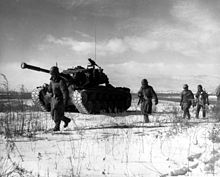
An important step on the way to the modern battle tank was the M26 Pershing . It was introduced into the American Army in 1945 and formed the backbone of the heavy armored weapon in the Korean War. He hardly played a role in the fight against the Wehrmacht, as only 20 to 28 tanks were used by the end of the war. Film recordings of the conquest of Cologne are known, in which a Pershing destroys a panther near the cathedral . The armor was on a par with the German Tiger and Panther , but clearly inferior to the King Tiger . The massive 90 mm cannon was just inferior to the German 8.8 cm L / 56 and 7.5 cm L / 70 cannon, which was only a minimal difference in view of the combat distances at the time. The cannon was clearly inferior to the longer and more powerful 8.8 cm L / 71 cannon, the King Tiger . The M26 had its heyday during the Korean War, in which it provided the backbone of the American tank weapon. The M26 showed the way to the M46 and M47 , which in turn formed the basis for the successful M48 Patton , which the USA exported to almost all allied states. The M26 was used until the 1960s before it was replaced by the better Patton .
Japan
Japan was not a major factor in tank production. Nonetheless, light tanks and self-propelled guns were also made in Japan. These tanks were launched with the Petillo. It's the Japanese version of the crank.
Japanese light tanks
One of the most commonly used Japanese tanks was the Type 95 Ha-Go . In the difficult terrain of the jungle in Burma and on the Pacific islands, the vehicle proved to be slightly superior to the US-American M3 and M5 with its maneuverability . With its armor, however, the vehicle was completely inferior to its American opponents. The strength of the armament was roughly equivalent. With the appearance of the American M24 Chaffee, the Type 95 was out of date with no chance.
Self-propelled guns
The Japanese paid more attention to the construction of self-propelled guns. When the production of heavy self-propelled guns was supposed to start, production capacity was largely paralyzed by the American blockade. An attempt was made to produce weapons with the resources already available. The results were improvisations that never reached the quality of German, Soviet or Western Allied weapons. The type 4 self-propelled gun is given as an example . The chassis and chassis came from the Type 97 tank . The howitzer from 1905 was actually retired in 1942, but was reactivated for the gun carriage.
Italy
Although Italy had been in a permanent state of war since 1936, the Italian designers did not even come close to keeping up with the pace of tank development.
Italian main battle tanks
The most famous Italian tanks are the Fiat L6 / 40 light tank and the M13 / 40 medium tank . Neither of the two tanks ever reached the stage of a usable frontal tank. The L6 / 40 was simply too lightly armored and with its 2 cm cannon too poorly armed to be dangerous for the British cruiser tanks or the Soviet T-34 . The tank was mainly used by the reconnaissance units of the tank divisions and the cavalry divisions. The Fiat M13 / 40 made its debut in North Africa. Here the defects of the vehicle became apparent almost immediately. It caught fire very easily when hit, had an unreliable engine, and was poorly armored and armed. The British captured some of these vehicles and wanted to fill gaps in their stocks. This turned out to be a mistake, the captured tanks did not stay in British ranks for long.
The Semovente self-propelled guns
The Italians were very impressed by the German assault guns. They then developed tank destroyers and turretless assault guns that were built in roughly the same style. The first variants like the L40 or the M 14/41 still had an open gun superstructure . Later variants like the Semovente 75/18 already had a closed structure. If these weapons were still used successfully in North Africa, they were almost useless in the mountains of Italy.
References
literature
- Thomas Müller : Chronicle of the military vehicles - German tanks . Brandenburgisches Verlagshaus, Bonn 2011, ISBN 978-3-941557-89-5 .
- George Forty: Tanks of World War Two , Bloomsbury USA, 1995, ISBN 978-1-85532-532-6 . (208 pages online PDF)
- Ralf Raths : From "Typenkompass" to "World of Tanks": The popular image of the armor of the Wehrmacht , in: Jens Westemeier (ed.): "So was the German soldier ...". The popular picture of the Wehrmacht , pp. 169–189, Paderborn (Ferdinand Schöningh) 2019. ISBN 3-506-78770-5 .
Web links
- Waffenhq.de
- Panzerbaer.de
- Tank archive online.
- Extensive representation of vehicles since the beginning of the development on Kampfpanzer.de
- Industry website for armored vehicles currently on the market at army-technology.com (English)
See also
- American military vehicles of World War II
- Australian military vehicles of World War II
- Belgian military vehicles of the Second World War
- British military vehicles of World War II
- List of tracked vehicles of the Wehrmacht
- French military vehicles of World War II
- Italian military vehicles of World War II
- Japanese military vehicles of World War II
- World War II Canadian military vehicles
- Polish military vehicles of World War II
- Soviet military vehicles of World War II
- Hungarian military vehicles of the Second World War
- Tanks (1914-1933)
- Cold War tanks
